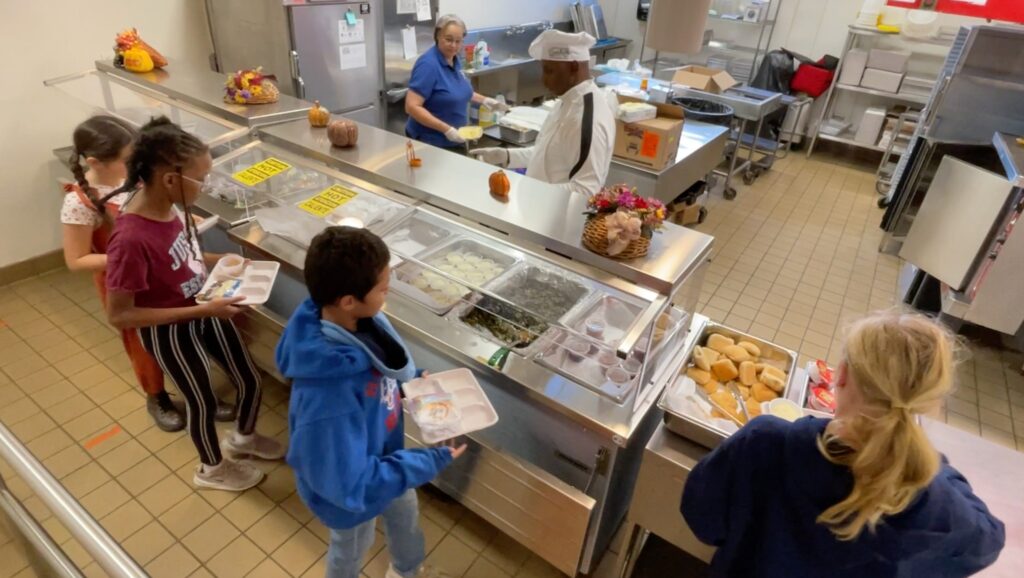
As most parents know, coming up with nutritious meals that your kids actually eat can be a difficult task. Imagine, then, planning breakfast and lunch for the roughly 9,000 students who get their meals from Chatham County Schools’ (CCS) cafeterias each school day. This herculean effort falls under the guidance of CCS’ school nutrition director, Cecile Teague. Not only does her staff have to come up with meals kids like, but they must follow strict nutrition guidelines and work within a tight budget.
The nutrition department essentially runs as a free-standing business, explains Teague. “Each of the schools’ kitchens is a restaurant and the students are the customers. You want to provide good quality food because you want the customers to come back every day.”
In addition, the cafeterias must make sure there is enough food. “We stress that the first kid in line and the last kid in line should all have the same options,” Teague said. “But planning is hard, and you may run short on chicken nuggets with three kids left in line at the end of lunch service. While we always have other options available, sometimes you just want the nuggets. Kids are so unpredictable.”
The nutrition department begins planning meals in September for the following year. This is essential because CCS participates in several programs where they purchase food together with other school districts to save money with bulk purchases. One of these programs is the North Carolina Procurement Alliance (NCPA), which is part of the North Carolina Department of Public Instruction. The NCPA works to obtain high quality, reasonably priced food that follows the strict dietary guidelines set by the federal government. These guidelines, which are part of the Child Nutrition Reauthorization Act updated by Michelle Obama in 2010, include limits on sugar, fat, and salt, and emphasize whole grains, fruits, vegetables, and low-fat dairy products.
CCS also participates in the National School Lunch Program (NSLP) and School Breakfast Program (SBP) administered by the U.S. Department of Agriculture’s (USDA) Food and Nutrition Service (FNS). These programs aim to provide schools with 100 percent American grown food known as USDA Foods. They also provide commodity foods, including cheese, chicken, and peanuts, that can be purchased in bulk and sent to manufacturers to process into items such as pizza, chicken nuggets, and peanut butter/jelly sandwiches. School districts that participate in these programs receive cash subsidies for reimbursable meals, i.e., nutritionally balanced meals with appropriate portions for each age group/grade served. To participate, all meals must meet federal guidelines and be offered for free or at a reduced price to eligible children.
For a lunch to be reimbursed, students must take three of five components—meat or meat alternative, grain, fruit, vegetable, and milk—and they have to choose one fruit or vegetable. So, while school lunches may get a bad rap, they are often healthier than what kids get at home. This is also true for breakfast and snacks. For example, the Pop-Tarts and cereals served at breakfast in school are made with whole grains and have less sugar than the ones found in grocery stores. Further, all snacks sold at school must meet Smart Snacks Standards, meaning they must be made from whole grains, and the first ingredient must be a fruit, vegetable, dairy food, or protein food. Like meals, snacks must meet certain nutrient standards for calories, sodium, fats, and total sugars. (See https://www.fns.usda.gov/tn/guide-smart-snacks-school for specifics.) The NCPA contracts with manufacturers to specially make these items. “The only thing we don’t have whole grain is our biscuits,” said Teague, “And we’re only allowed to serve those two times a week.”
Here are a few more pleasantly surprising facts about the food items available at school:
- Corn dogs are made from chicken and have no nitrates or nitrites.
- Chicken strips are made from chicken breast, not manufactured chicken like you find at McDonald’s.
- Pizza crust is made from whole grain.
- Orange chicken is the same that’s sold at Trader Joe’s.
- Barbecue comes from Brookwood Farms in Siler City.
- Hamburger patties are premium meat.
- Juice boxes are 100% juice and include vegetable juice.
Deciding on menus takes into account many factors beyond nutritional requirements including staff, space, time, equipment, and, of course, cost. As not every school in Chatham County is equipped with a full-service kitchen, and because of limited staff, most of the food is not made from scratch, but rather frozen. Salads are an exception. Cafeteria staff chop the romaine, shred the cabbage, and add the shredded carrots.
Another consideration is food waste. Whether kids don’t like what’s on their plate or they don’t have time to eat everything, a sizable portion of food gets thrown away every day. “We were making bigger salads with popcorn chicken,” Teague said. “But … the kids would just want the popcorn chicken and the salad would get thrown away.”
Food waste is also why a lot of the food is prepackaged. “If it’s on the line at the end of meal service and it’s not prepackaged, it has to be thrown away every day,” Teague said.
When CCS decided to make breakfast and lunch free for all students in 2024-25, this added yet another component to the meal planning puzzle. While most CCS schools are eligible for free meals through the Community Eligibility Provision* (CEP), there are three that are not: Chatham Grove Elementary, Pollard Middle School, and Seaforth High School. Fortunately, the Chatham County Board of Education approved covering the cost of free meals at the three schools that do not meet CEP requirements. This means all CCS’s students are eligible for free meals without having to submit an application for meal benefits.†
The cost to cover free meals for students at the three schools was $600,000, which made up 10 percent of the nutrition department’s budget for 2024-25. Another 75 percent of the budget accounted for reimbursed meals from the USDA, and 15 percent from snack sales and catering. (CCS provides meals for Chatham Charter School and Central Carolina Academy in Lee County.) Overall, the budget was $6 million. Due to rising food costs and fewer snack sales than anticipated, the proposed budget for 2025-26 is $6.5 million. About half of the proposed budget will go to payroll. The remainder will pay for everything else including food purchases, food processing supplies, equipment purchases and repairs, and miscellaneous supplies such as uniforms and workshop expenses.
So just like a restaurant, the nutrition department has to make predictions about what types of food will sell, how many patrons it will serve, and account for any mishaps, such as equipment failure or not being able to get a particular food when they need it. “It really is like a big puzzle,” Teague said. “We have to figure out where we can save money while also making smart choices about the quality of food that kids will want to eat because, at the end of the day, our goal is to ensure no student goes hungry while they are at school.”
While it’s still unclear what will happen to school nutrition programs at the federal level, Teague said, “We will keep feeding for free as long as we can.”
*CEP is a federal program that provides funding for school meals based on the percentage of students in a school who are directly certified for participation in a government program such as SNAP or may be identified as a homeless or migrant student.
†At its July 14, 2025, meeting, the CCS Board of Education voted to reinstate meal charges for the 2025-26 school year at the three schools that do not currently qualify for CEP: Chatham Grove Elementary, Pollard Middle, and Seaforth High.
